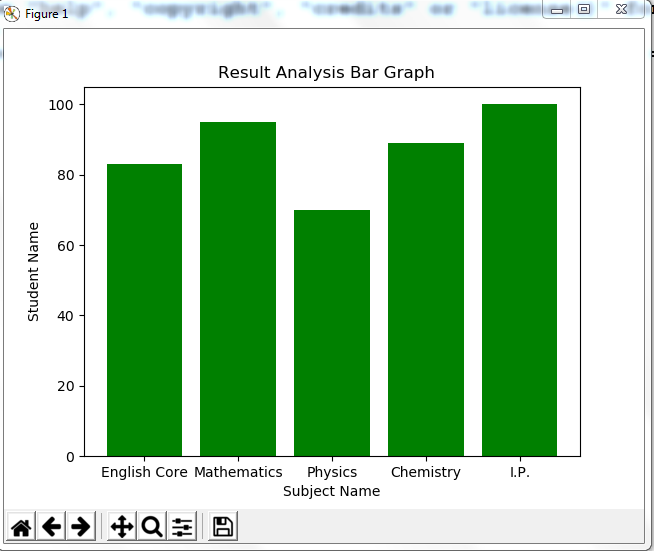Last updated on October 9th, 2022 at 10:01 pm
Practical File Class 12 IP
Data Handling
Program 1: Create a panda’s series from a dictionary of values and a ndarray
'''Python program to create a panda’s series from a dictionary of values and a ndarray''' import pandas as pd import numpy as np s=pd.Series(np.array([2,4,5,7,9,8,9])) print(s)
Output:
0 2 1 4 2 5 3 7 4 9 5 8 6 9 dtype: int32 >>>
# import panda lib as pd
import pandas as pd
# creating a dictionary
dictionary={'A':10, 'B':20, 'C':30}
#creating a series
series=pd.Series(dictionary)
print(series)
Output:
A 10 B 20 C 30 dtype: int64 >>>
Program 2:Given a Series, print all the elements that are above the 75th percentile.
# import panda lib as pd
import pandas as pd
import numpy as np
series=pd.Series(np.array([1,4,6,7,8,9,11]))
print (series)
result=series.quantile(q=0.75)
print()
print ("75 percentile of the series is : ")
print(result)
print()
print ("The Elements above 75 percentile is : ")
print(series[series>result])
Output:
0 1 1 4 2 6 3 7 4 8 5 9 6 11 dtype: int32 75 percentile of the series is : 8.5 The Elements above 75 percentile is : 5 9 6 11 dtype: int32 >>>
Program 3: Create a Data Frame quarterly sales where each row contains the item category, item name, and expenditure. Group the rows by the category and print the total expenditure per category.
# import panda lib as pd
import pandas as pd
dictionary={'item_cat':['Tata', 'Hyundai', 'Maruti', 'Renault'],
'item_name':['Harrier', 'KIA', 'Swift', 'Duster'],
'expenditure':[2000000, 700000, 900000, 1400000]}
quarter_sales=pd.DataFrame(dictionary)
print (quarter_sales)
q_sale=quarter_sales.groupby('item_cat')
print("Result after Filtering DataFrame")
print (q_sale['item_cat','expenditure'].sum())
Output:
item_cat item_name expenditure 0 Tata Harrier 2000000 1 Hyundai KIA 700000 2 Maruti Swift 900000 3 Renault Duster 1400000 Result after Filtering DataFrame expenditure item_cat Hyundai 700000 Maruti 900000 Renault 1400000 Tata 2000000 >>>
Program 4:Create a data frame for examination result and display row labels, column labels data types of each column and the dimensions
import pandas as pd
dictionary={'class':['I', 'II','III','IV','V','VI','VII','VIII','IX','X','XI','XII', ],
'pass_percentage':[100,100,100,100,100,100,100,100,96,99.10,98,97.7]}
result=pd.DataFrame(dictionary)
print (result)
print (result.dtypes)
print("shape of the dataframe is : ")
print (result.shape)
Output:
class pass_percentage 0 I 100.0 1 II 100.0 2 III 100.0 3 IV 100.0 4 V 100.0 5 VI 100.0 6 VII 100.0 7 VIII 100.0 8 IX 96.0 9 X 99.1 10 XI 98.0 11 XII 97.7 class object pass_percentage float64 dtype: object shape of the dataframe is : (12, 2) >>>
Program 5:Filter out rows based on different criteria such as duplicate rows.
'''Python program to Filter out rows based
on different criteria such as duplicate rows'''
import pandas as pd
dic={'Name':['Ajay','Banti','Chandrkant','Deepak','Geeta','Harshit'],
'CS_Marks':[80,78,80,92,78,99]}
marks=pd.DataFrame(dic)
print(marks)
#Finding duplicate rows
print("Duplicate Rows : ")
duplicateRow = marks[marks.duplicated('CS_Marks',keep=False)]
print(duplicateRow)
Output:
CS_Marks Name 0 80 Ajay 1 78 Banti 2 80 Chandrkant 3 92 Deepak 4 78 Geeta 5 99 Harshit Duplicate Rows : CS_Marks Name 0 80 Ajay 1 78 Banti 2 80 Chandrkant 4 78 Geeta >>>
Program 6:Importing and exporting data between pandas and CSV file
'''Importing data between pandas and CSV file'''
import pandas as pd
#make data frame
df=pd.read_csv("d:\std.csv")
print(df)
Output:
ROLL No Student Name Class Marks 0 1 Arnav III 100 1 2 Bikram V 98 2 3 Charu VII 99 3 4 Dhruv VIII 91 4 5 Harshit X 80 >>>
'''Exporting data between pandas and CSV file'''
import pandas as pd
dic=[{'Name': 'Amit', 'Class': 12},
{'Name': 'Abhay', 'Class': 10},
{'Name': 'Harshit', 'Class': 9},
{'Name': 'Arnav', 'Class': 11}]
#make data frame
df_1=pd.DataFrame(dic)
# saving the data frame
df_1.to_csv('d:\Dataframe1.csv')
5.2 Visualization
Program 7:Given the school result data, analyses the performance of the students on different parameters, e.g subject wise or class wise.
import matplotlib.pyplot as plt
subject=['English Core','Mathematics', 'Physics', 'Chemistry', 'I.P.']
percentage=[83,95,70, 89, 100]
plt.bar(subject,percentage, align='center', color='green')
plt.xlabel('Subject Name')
plt.ylabel('Student Name')
plt.title('Result Analysis Bar Graph ')
plt.show()
Output:

Program 8:For the Data frames created above, analyze, and plot appropriate charts with title and legend.
import matplotlib.pyplot as plt
import numpy as np
place=['1st','2nd','3rd']
pcm_percentage=[80,90,100]
pcb_percenatge=[90,100,80]
comm_percentage=[100,90,80]
x=np.arange(len(place))
plt.bar(x,pcm_percentage, label='PCM', width=0.25, color='red')
plt.bar(x+.25,pcb_percenatge, label='PCB', width=0.25, color='green')
plt.bar(x+.50,comm_percentage, label='Commerce', width=0.25, color='yellow')
plt.xticks(x,place)
plt.xlabel('Position')
plt.ylabel('Percentage')
plt.title('Result Analysis Bar Graph')
plt.legend()
plt.show()
Output:

Program 9:Take data of your interest from an open source (e.g. data.gov.in), aggregate and summarize it. Then plot it using different plotting functions of the Matplotlib library.
import pandas as pd
import matplotlib.pyplot as plt
dframe=pd.read_csv("D:\Covid_Vaccine.csv")
print(dframe)
Output:

import pandas as pd
import matplotlib.pyplot as plt
dframe=pd.read_csv("D:\Covid_Vaccine.csv")
slices=(dframe['TOTAL DOSES ADMINISTERED'].head(6))
states=(dframe['STATE/UTS'].head(6))
colours=['c','b','y','m','r','gold']
exp=[0,0,0,0,0,0.1]
plt.pie(slices, labels=states, colors=colours, startangle=90, explode=exp, shadow=True, autopct='%.1f%%')
plt.title('Vaccine Adminstrated ')
plt.legend()
plt.show()
Output:

Data Management
1. Create a student table with the student id, name, and marks as attributes where the student id is the primary key.
CREATE TABLE Student ( Student_ID int Primary Key, Student_Name varchar(25), Marks int );

2. Insert the details of a new student in the above table.
insert into student values(101, Amit, 87);

3. Delete the details of a student in the above table.
delete from student where Student_ID=101;
4. Use the select command to get the details of the students with marks more than 80.
select * from student where marks>80;
5. Find the min, max, sum, and average of the marks in a student marks table.
select max(marks), min(marks), sum(marks) , avg(marks) from student;
6. Write a SQL query to order the (student ID, marks) table in descending order of the marks.
select * from student order by marks desc;